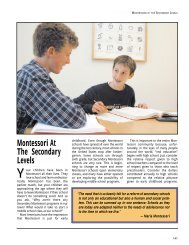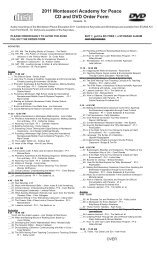Tim Seldin & Paul Epstein Ph.D. An Education for Life
Tim Seldin & Paul Epstein Ph.D. An Education for Life
Tim Seldin & Paul Epstein Ph.D. An Education for Life
Create successful ePaper yourself
Turn your PDF publications into a flip-book with our unique Google optimized e-Paper software.
MONTESSORI PROGRAMS<br />
toms, housing, diet, government,<br />
industry, the arts, history,<br />
and dress. They learn to<br />
treasure the richness of their<br />
own cultural heritage and<br />
those of their friends.<br />
The children also study<br />
the emergence of human<br />
beings during the old and<br />
new stone ages, the development<br />
of the first civilizations,<br />
and the universal needs common<br />
to all humanity. For<br />
older elementary students,<br />
the focus is respectively on<br />
early man, ancient civilizations,<br />
and early-American<br />
history.<br />
Montessori tries to present<br />
a sense of living history<br />
at every level through direct<br />
hands-on experience. Students<br />
build models of<br />
ancient tools and structures,<br />
prepare their own manuscripts,<br />
make ceremonial<br />
masks, and re-create all sorts<br />
of artifacts of the everyday<br />
life of historical eras. Experiences<br />
such as these make it<br />
much easier <strong>for</strong> Montessori<br />
children to appreciate history<br />
as it is taught through<br />
books.<br />
While Montessori schools<br />
are communities apart from<br />
the outside world, in which<br />
children can first begin to<br />
develop their unique talents,<br />
they are also consciously<br />
connected to the local,<br />
national, and global communities.<br />
The goal is to lead<br />
each student to explore,<br />
understand, and grow into<br />
full and active membership<br />
in the adult world.<br />
Field trips provide opportunities<br />
to explore the world<br />
outside the classroom.<br />
92<br />
(Above) Research Card Materials<br />
Younger elementary children<br />
often use simplified research card<br />
material and charts in their studies.<br />
(Left) The Imaginary<br />
Island Puzzle<br />
The Imaginary Island Puzzle<br />
introduces students in elementary<br />
classes to thirty-eight land and<br />
water <strong>for</strong>ms. They study vocabulary<br />
and definitions of such words as<br />
isthmus, butte, tributary, archipelago,<br />
bight, lagoon, and more.<br />
Children also learn to plot longitude<br />
and latitude and analyze the<br />
flora and fauna of a region. With<br />
the use of eighty-four puzzle pieces,<br />
students are able to create an<br />
infinite variety of islands of their<br />
own design, modifying them at will,<br />
and rein<strong>for</strong>cing vocabulary words<br />
during the process.




